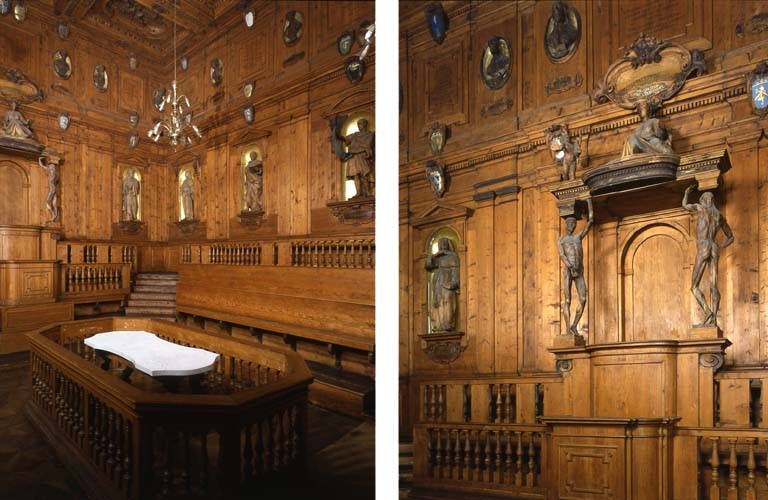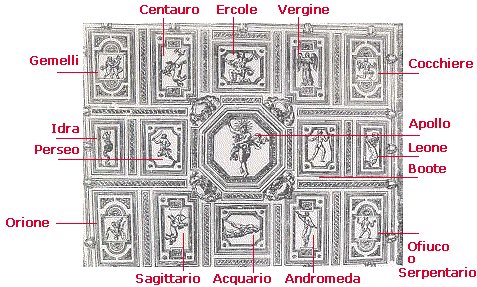The anatomical theatre
The hall, called “theatre” because of its amphitheatre-like shape, was designed in 1637 for the anatomical lessons and it was built by the Bolognese architect Antonio Paolucci, called “il Levanti", a pupil of the Carracci.

The hall was covered in spruce wood and decorated with two orders of statues depicting twelve famous physicians (Hippocrates, Galen, Fabrizio Bartoletti, Girolamo Sbaraglia, Marcello Malpighi, Carlo Fracassati, Mondino de’ Liuzzi, Bartolomeo da Varignana, Pietro d’Argelata, Costanzo Varolio, Giulio Cesare Aranzio, Gaspare Tagliacozzi) and, at the top, there are twenty of the most famous anatomists of the Bolognese Studio.
The desk of the Lecturer, which stands above that of the demonstrator, is flanked by two statues called “Spellati” (”Skinned men”), sculpted in 1734 by Ercole Lelli, a famous wax modeller of the Institute of Sciences. Above the canopy, a seated female figure, the allegory of Anatomy, receives a femur from a winged putto as a tribute (instead of a flower).
The anatomical room has sustained significant damage due to the bombing that, on the 29th January 1944, destroyed this wing of the building; it was rebuilt immediately after the war by reusing the original wooden sculptures that, fortunately, have been recovered from the ruins.
The decoration of the ceiling
The coffered ceiling, built in 1645 by Antonio Levanti, is decorated with symbolic figures representing fourteen constellations and Apollo, the protector of Medicine, positioned in the centre.
The choice to paint an astrological theme goes back to the tradition of consulting the stars before proceeding with operations or administering drugs, according to a conception of medicine that is influenced throughout Europe by the ancient science spread by the Arabs since the time of the conquest of Spain.
Astrology was associated with medicine, and every part of the body was placed under the protection of a zodiacal sign. Moreover, astrology continued to be a subject of study at the University of Bologna at the end of the seventeenth century. The decoration of the ceiling reflects a certain way of conceiving man and his biological life in relation to nature and to cosmos.
The restoration
The Theatre has undergone several restoration works over time, the largest of which dates back to the reconstruction made after the bombing of the 29th January 1944, which had damaged it in full, fortunately without destroying the sculptures and the coats of arms.
On occasion of that restoration, the wooden covering of the walls had been completely redone according to the original design, reintegrating the ancient statues in their original positions.
In 2006, the conservation problems of the spruce wood that covers the hall induced the Municipality of Bologna to plan a restoration to safeguard the structure of the walls and the ceiling, and it was extended to all decorations and statues, threatened by the inexorable flow of time and by the environmental pollution.
The cleaning of the woods was followed by an examination of their state of conservation, in order to proceed to preventive treatments against pest attack, disinfestation and treatment with anti-virus substances, water repellents and flame-retardants.
The intervention, which costed 68 000 euros, was financed in large part thanks to the proceeds of the Game of Lotto: the restoration of the Anatomical Theatre was the winner of the “Lotto per l’arte” competition in 2003, organized by Lottomatica, which placed this monument at the top spot, among the three monuments which had been considered for the artistic initiatives in the Emilia Romagna region.
The Municipality of Bologna was thus able to receive a contribution of 50 000 euros.
The restoration project was curated by the Public Works department of the Municipality of Bologna and it was run by the indent house “Il Leonardo” of Bologna, which had won the contract.
The works lasted six months, respecting the scheduled time to return as soon as possible an historical and artistic jewel to the city and to its Italian and foreign visitors.
